 W
WArch of Nero is an 1846 oil on canvas painting by Thomas Cole. It is currently on display at the The Newark Museum of Art.
 W
WThe Arch of Titus is an 1871 oil painting on canvas. It was a collaboration between three American painters: George Peter Alexander Healy, Frederic E. Church, and Jervis McEntee. It depicts the Arch of Titus in Rome, with the Colosseum in the background, and includes portraits of Henry Wadsworth Longfellow and his daughter Edith, and the three artists. The painting is currently on display in the Newark Museum in Newark, New Jersey.
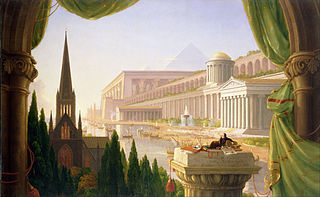 W
WThe Architect's Dream is an 1840 oil painting created by Thomas Cole for New York architect Ithiel Town. Cole incorporated pieces of architecture from Egyptian, Greek, Roman, and Gothic styles in various different parts of the painting, having dabbled in architecture previously. Cole finished the painting in only five weeks and showed it in the National Academy of Design annual exhibition that year. However, the painting was not well received by Town, who refused to accept the painting because he claimed that it was "exclusively architectural".
 W
WExpulsion from the Garden of Eden was painted in 1828 by English-born American painter Thomas Cole. It belongs to the collection of the Museum of Fine Arts, Boston and is on display in their Waleska Evans James Gallery. This landscape painting exemplifies the style of the Hudson River School, which was a group of American landscape painters that Thomas Cole is credited with founding. On the lower left part of the cliff, Cole signed his name as "T Cole".
 W
WThe Course of Empire is a series of five paintings created by Thomas Cole in the years 1833–1836. It is notable in part for reflecting popular American sentiments of the times, when many saw pastoralism as the ideal phase of human civilization, fearing that empire would lead to gluttony and inevitable decay. The theme of cycles is one that Cole returned to frequently, such as in his The Voyage of Life series. The Course of Empire comprises the following works: The Course of Empire – The Savage State; The Arcadian or Pastoral State; The Consummation of Empire; Destruction; and Desolation. All the paintings are oil on canvas, and all are 39.5 inches by 63.5 inches except The Consummation of Empire which is 51″ by 76″.
 W
WCross at Sunset is an oil on canvas painting by Thomas Cole. Believed to have been created around 1848, it was left unfinished due to his premature death that year.
 W
WGenesee Scenery, also called Mountain Landscape with Waterfall, is an 1847 oil on canvas painting by British-born American painter Thomas Cole, founder of the Hudson River School. The work depicts the Genesee River in New York State.
 W
WIl Penseroso is an 1845 oil on canvas painting by British-American painter Thomas Cole, founder of the Hudson River School. The work is currently possessed by the Los Angeles County Museum of Art.
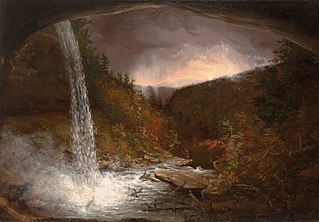 W
WKaaterskill Falls is an 1826 oil on canvas painting by British-American painter Thomas Cole, founder of the Hudson River School. It depicts the Kaaterskill Falls in Upstate New York.
 W
WKindred Spirits (1849) is a painting by Asher Brown Durand, a member of the Hudson River School of painters. It depicts the painter Thomas Cole, who had died in 1848, and his friend, the poet William Cullen Bryant, in the Catskill Mountains. The landscape painting, which combines geographical features in Kaaterskill Clove and a minuscule depiction of Kaaterskill Falls, is not a literal depiction of American geography. Rather, it is an idealized memory of Cole's discovery of the region more than twenty years prior, his friendship with Bryant, and his ideas about American nature.
 W
WLake with Dead Trees, also known as Catskill, is an oil on canvas painting completed in 1825 by Thomas Cole. Depicting a scene in the Catskill Mountains in southeastern New York State, this work is one of five of Cole's 1825 landscapes to found the mid-19th century American art movement known as the Hudson River School.
 W
WThomas Cole (1801–1848) was a British-born American artist and the founder of the Hudson River School art movement. Cole is widely regarded as the first significant American landscape painter. He was known for his romantic landscape and history paintings. Influenced by European painters, but with a strong American sensibility, he was prolific throughout his career and worked primarily with oil on canvas. His paintings are typically allegoric and often depict small figures or structures set against moody and evocative natural landscapes. They are usually escapist, framing the New World as a natural eden contrasting with the smog-filled cityscapes of Industrial Revolution-era Britain, in which he grew up. His works, often seen as conservative, criticize the contemporary trends of industrialism, urbanism, and westward expansion.
 W
WView from Mount Holyoke, Northampton, Massachusetts, after a Thunderstorm, commonly known as The Oxbow, is a seminal landscape painting by Thomas Cole, founder of the Hudson River School. The painting depicts a Romantic panorama of the Connecticut River Valley just after a thunderstorm. It has been interpreted as a confrontation between wilderness and civilization.
 W
WThe Parthenon is a large 1871 painting by American artist Frederic Edwin Church which is in the collection of the Metropolitan Museum of Art, New York City.
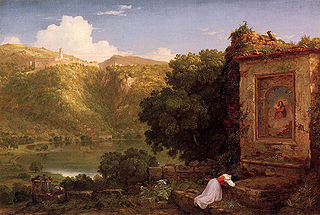 W
WIl Penseroso is a vision of poetic melancholy by John Milton, first found in the 1645/1646 quarto of verses The Poems of Mr. John Milton, both English and Latin, published by Humphrey Moseley. It was presented as a companion piece to L'Allegro, a vision of poetic mirth. The speaker of this reflective ode dispels "vain deluding Joys" from his mind in a ten-line prelude, before invoking "divinest Melancholy" to inspire his future verses. The melancholic mood is idealised by the speaker as a means by which to "attain / To something like prophetic strain," and for the central action of Il Penseroso – which, like L'Allegro, proceeds in couplets of iambic tetrameter – the speaker speculates about the poetic inspiration that would transpire if the imagined goddess of Melancholy he invokes were his Muse. The highly digressive style Milton employs in L'Allegro and Il Penseroso dually precludes any summary of the poems' dramatic action as it renders them interpretively ambiguous to critics. However, it can surely be said that the vision of poetic inspiration offered by the speaker of Il Penseroso is an allegorical exploration of a contemplative paradigm of poetic genre.
 W
WRoman Campagna, also called Ruins of Aqueducts in the Campagna Di Roma is an 1843 oil on canvas painting by Thomas Cole. It is currently displayed at the Wadsworth Atheneum in Connecticut.
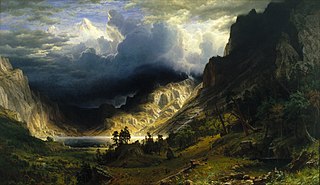 W
WA Storm in the Rocky Mountains, Mt. Rosalie is an 1866 landscape oil painting by German-American painter Albert Bierstadt that was inspired by sketches created on an 1863 expedition.
 W
WThe Subsiding of the Waters of the Deluge is an 1829 painting by English-born American artist Thomas Cole depicting the aftermath of the Great Flood.
 W
WSummer Twilight, A Recollection of a Scene in New-England is an 1834 oil on wood painting by British-born American painter Thomas Cole, the founder of the Hudson River School. It is currently owned by the New-York Historical Society.
 W
WSunset, View on the Catskill is an 1833 oil on wood painting by British-American painter Thomas Cole. It is currently owned by the New-York Historical Society.
 W
WThe Dead Abel is an 1832 oil on paper painting by British-American painter Thomas Cole, the founder of the Hudson River School. It depicts the dead biblical figure Abel. It was originally intended to be a study for a larger painting; however, this other work was never created.
 W
WThe Fountain of Vaucluse ia an 1841 oil on canvas painting by British-American painter Thomas Cole, founder of the Hudson River School. The work depicts the home of Petrarch.
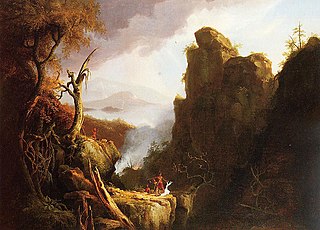 W
WThe Last of the Mohicans: The Death of Cora, also known as Indian Sacrifice, is a c. 1827 painting by British-American painter Thomas Cole, the founder of the Hudson River School. The painting depicts the death of Cora from the 1826 American novel The Last of the Mohicans. It is one of four such paintings by Cole which depict scenes from the novel. The painting is currently owned by the University of Pennsylvania.
 W
WThe Titan's Goblet is an oil painting by the English-born American landscape artist Thomas Cole. Painted in 1833, it is perhaps the most enigmatic of Cole's allegorical or imaginary landscape scenes. It is a work that "defies full explanation", according to the Metropolitan Museum of Art. The Titan's Goblet has been called a "picture within a picture" and a "landscape within a landscape": the goblet stands on conventional terrain, but its inhabitants live along its rim in a world all their own. Vegetation covers the entire brim, broken only by two tiny buildings, a Greek temple and an Italian palace. The vast waters are dotted with sailing vessels. Where the water spills upon the ground below, grass and a more rudimentary civilization spring up.
 W
WView of Florence from San Miniato is an oil on canvas painting by American artist Thomas Cole.
 W
WView of Fort Putnam is an 1825 oil on canvas painting of the Hudson River with a view of Fort Putnam by British-American painter Thomas Cole, who founded the Hudson River School. It is currently owned by the Philadelphia Museum of Art.